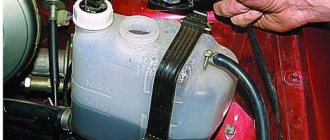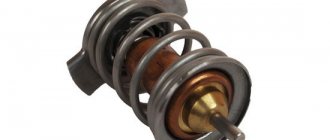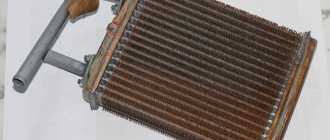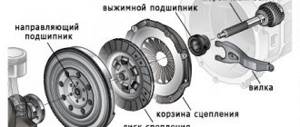Cars admin26.02.2020
Initially, it should be noted that the cooling system is an important system, the functioning of which determines the normal operation of the engine. Various problems in the cooling system lead to serious breakdowns, so they should be identified and corrected promptly to avoid serious and costly breakdowns.
One of the important elements of the cooling system of the VAZ-2107 car is the radiator cap. Many people are accustomed to the fact that the lid is a regular stopper that helps limit the flow of liquid from the container. In addition to this main function, the VAZ 2107 radiator cap has another important function, which we will learn about in detail in the material.
Features of the VAZ 2107 radiator cap
The radiator cap for cars of the Lada family, including the VAZ 2107, combines two important functions:
- Limiting the flow of coolant from the system, or more precisely from the radiator.
- The lid also works as a valve.
The presence of a spring in the design of the plug is not superfluous, since it is with its help that excess pressure is released from the cooling system. The plug is a metal structure consisting of two parts connected by a spring mechanism.
It is important to know! The plug is considered to be in good condition when the spring is compressed with force. If no force is required when compressing the spring, the plug should be replaced immediately.
Many VAZ-2107 car owners often have a question about how to check the heat exchanger (radiator) cap for serviceability? This is quite simple to do, for which there are two ways, which will be discussed below.
The principle of operation of the heat exchanger cover on the VAZ 2107
The operating principle of the radiator cap is quite simple. This element has inlet and outlet valves, through which the heat exchanger is connected to the expansion tank using a hose. The intake valve is not pressed against the gasket, so when the engine heats up or cools down, fluid circulates into the expansion tank.
When the coolant temperature increases, the intake valve does not have time to release it into the expansion tank, after which it closes. When the pressure increases to 50 kPa, the outlet valve opens. As a result, some of the liquid flows into the expansion tank. There is a rubber valve in the expansion tank plug, which is activated when the pressure in the tank reaches close to atmospheric pressure.
It is important to know! Over time, the functioning of the radiator cap becomes impaired. This product cannot be repaired and should be replaced with a new one.
Features of checking the proper operation of the heat exchanger plug on the seven
How to check the serviceability of the radiator plug of a VAZ 2107 car? Checking is carried out in two ways:
- The appearance of the plug is assessed, as well as the serviceability of the spring.
- The serviceability is checked with the lid running. To do this, you need to squeeze the pipe that fits the heat exchanger with your hand.
To carry out such a check, it is necessary that the engine is still warm, which means that there is residual pressure in the system. If, when squeezing the pipe with your hand, a “grunting” sound is heard in the heat exchanger cover, this sound is a sign of the functioning of the cover valve. If the valve is faulty, excess pressure in the device can lead to rupture of pipes, radiator and even stove.
When problems arise with the functioning of the cooling system, be sure to pay attention to such an important element as the radiator cap. Make sure it is in good working order. If it is not working properly, then it is better not to tempt fate, but to replace it immediately so that you do not have to overhaul the engine in the near future. More details about the features of checking the serviceability of the device in question can be seen in the video above.
The operation of the internal combustion engine of any car is associated with high temperatures. The internal combustion engine heats up during the combustion of the fuel-air mixture in the cylinders and as a result of friction of its elements. The cooling system helps to avoid overheating of the power unit.
Repair of Semyon (VAZ 2107): replacement of the radiator - Autocadabra
First of all, I decided to talk about replacing the radiator. Due to its rusty fluidity, the consumption of antifreeze was about a liter per week.
Having chosen the weekend, Yurka and I started repairing our cars. He also has a seven.
Having stopped at the auto shop and stocked up, we rushed to the garage. The radiator, by the way, costs a thousand rubles and is crap - flimsy, plastic, all so poor, in a word - daaz. But due to the lack of alternatives, I had to buy it.
So, the workplace. Laptop on the hood, tools on the roof. Everything is as it should be:
The laptop has the Internet with instructions.
We are starting to replace the radiator. First you need to drain the old antifreeze.
Actually, there is a special tap on the radiator, but I decided not to even try to unscrew it, and immediately removed the lower tube. It started leaking. The instructions stated that it is not necessary to replace the antifreeze, you can refill the old one. Before draining, I jacked up the car a little and prudently placed a basin under the pipe. Antifreeze poured out, a black slurry like oil, and I came to the conclusion that I didn’t really want to pour it back into the system. Again, I didn’t drain the engine because I didn’t want to mess with the stuck nut.
I removed the old radiator, surprisingly, without any problems. Those guys who have dealt with the repair of older cars know that you can rarely remove anything on them just like that, without a “trick” or other twists.
I tried on a new radiator. Everything would be fine, but the problem is that the lower tube does not reach. There was a five-ruble radiator, but I bought a seven-ruble one. I had to go to the store for antifreeze and the down tube.
Yurka went shopping, and while I was looking at the new radiator, I discovered the presence of a mysterious additional hole with an internal thread, next to the hole for the lower radiator tube. It turned out that this was the hole for the temperature sensor. The sensor turns on the fan when the antifreeze temperature exceeds a certain value. I have forced cooling and don’t need a sensor - the fan always spins. Unnecessary, the hole needed to be plugged with something. There was no bolt or plug in the store, so I had to buy an unnecessary sensor.
When Yurka finally arrived with antifreeze, a sensor and a pipe, I screwed on the new radiator and plugged in the lower pipe and discovered a new bonus. Now the top one couldn’t reach:
I probably should have guessed right away that both tubes didn’t fit, but somehow it didn’t work out for me. Be that as it may, the pipes were no longer available, and the stores were closed. I began to invent a design for extending the tube. An adapter was needed. I “removed” the copper tube from the old radiator using a hammer and “fixed” it as it should:
Just an hour of work, and the solution to the problem is ready. The old, short tube is cut and extended by the old lower tube:
Everything is ready, but the problem is that the stoplights don’t light up. They don't burn and that's it. I started rummaging through the electrics in the back and front. I walk and wander around the car with the tester. I looked through everything under the dash. Tugged and poked. Everything is to no avail - they don’t work.
In the end, it turned out that I had a separate “+” coming from the positive terminal to the light in the cabin, stoplights and something else.
This separate pin was not attached. When replacing the radiator, I removed the battery and forgot about this output.
On the way home, we take a photo of Semyon with the new nasty blue parking lights (they were sold in the store as white):
General characteristics of the VAZ 2107 cooling system
The VAZ 2107 engine of all models has a sealed liquid cooling system with forced circulation of coolant (coolant).
Purpose of the cooling system
The cooling system is designed to maintain the optimal temperature of the power unit during its operation and timely, controlled removal of excess heat from heating components. Individual elements of the system are used to heat the interior during the cold season.
Cooling system parameters
The cooling system of the VAZ 2107 has a number of parameters that affect the operation and performance of the power unit, the main of which are:
- amount of coolant - regardless of the fuel supply method (carburetor or injection) and engine size, all VAZ 2107 use the same cooling system. According to the manufacturer's requirements, its operation (including interior heating) requires 9.85 liters of refrigerant. Therefore, when replacing antifreeze, you should immediately purchase a ten-liter container;
- engine operating temperature - The operating temperature of the engine depends on its type and volume, the type of fuel used, the number of crankshaft revolutions, etc. For the VAZ 2107 it is usually 80–95 0 C. The engine is heated to operating condition depending on the ambient temperature for 4–7 minutes. If there is a deviation from these values, it is recommended to immediately diagnose the cooling system;
- coolant operating pressure - Since the cooling system of the VAZ 2107 is sealed, and antifreeze expands when heated, a pressure exceeding atmospheric pressure is created inside the system. This is necessary to increase the boiling point of the coolant. So, if under normal conditions water boils at 100 0 C, then when the pressure increases to 2 atm, the boiling point rises to 120 0 C. In the VAZ 2107 engine, the working pressure is 1.2–1.5 atm. Thus, if the boiling point of modern coolants at atmospheric pressure is 120–130 0 C, then under operating conditions it will increase to 140–145 0 C.
The design of the VAZ 2107 cooling system
The main components of the VAZ 2107 cooling system include:
- water pump (pump);
- main radiator;
- main radiator fan;
- interior heater (stove) radiator;
- stove tap;
- thermostat (thermostat);
- expansion tank;
- coolant temperature sensor;
- coolant temperature sensor indicator;
- control temperature sensor (only in injection engines);
- fan switch sensor (only in carburetor engines);
- connecting pipes.
This should also include the engine cooling jacket - a system of special channels in the cylinder block and cylinder head through which coolant circulates.
Video: design and operation of the engine cooling system
Water pump (pump)
The pump is designed to ensure continuous forced circulation of coolant through the engine cooling jacket during operation. It is a conventional centrifugal pump that pumps antifreeze into the cooling system using an impeller. The pump is located on the front of the cylinder block and is driven by the crankshaft pulley through a V-belt.
Radiator replacement
If there is a need to replace the radiator, remember the first golden rule - the engine must be cold before dismantling the device. Therefore, if you just arrived at the garage, let the car sit for a couple of hours. Better yet, leave the car and come back tomorrow.
The replacement procedure itself is as follows.
- Unscrew the plug from the expansion tank and the cylinder and radiator plugs.
- Drain the coolant into a large container.
- Disconnect the radiator ventilation system from the battery.
- Remove the silicone pipes of the VAZ 2114 cooling system by disconnecting them from the radiator and tank.
- Remove the mounting bolts from the casing.
- Hold the radiator and remove the skin and fan together.
- This will completely free the radiator, so you can easily replace it with a new one.
- Assembly of the unit is carried out in reverse order. After replacing the radiator, start the engine and check the efficiency of the new unit.
https://youtube.com/watch?v=JYC8ijuYJdg
Coolant
The manufacturer recommends using exclusively antifreeze as a coolant for the VAZ 2107. For the uninitiated car enthusiast, antifreeze and antifreeze are one and the same thing. Antifreeze is usually called all coolants without exception, regardless of where and when they were produced. Antifreeze is a type of antifreeze produced in the USSR. The name is an abbreviation for “separate laboratory organic synthesis technology.” Without exception, all coolants contain ethylene glycol and water. The differences are only in the type and quantity of anti-corrosion, anti-cavitation and anti-foam additives added. Therefore, for the VAZ 2107 the name of the coolant is not of great importance.
The danger comes from cheap, low-quality coolants or outright counterfeits, which have recently become widespread and are often found on sale. The result of using such liquids can be not only a radiator leak, but also failure of the entire engine. Therefore, to cool the engine, you should buy coolant from proven and well-established manufacturers.
Possibility of tuning the VAZ 2107 cooling system
You can increase the efficiency of the VAZ 2107 cooling system in various ways. Someone installs a fan from a Kalina or Priora on the radiator, someone tries to better heat the interior by adding an electric pump from a Gazelle to the system, and someone installs silicone pipes, believing that with them the engine will warm up faster and cool down. However, the feasibility of such tuning is highly questionable. The cooling system of the VAZ 2107 itself is quite well thought out. If all its elements are in good working order, the engine will never overheat in the summer, and in winter the cabin will be warm even without turning on the heater fan. To do this, you only need to periodically pay attention to system maintenance, namely:
- fill only high-quality coolant into the engine;
- change the coolant every 50 thousand km with a complete drain and flushing of the system;
- monitor the coolant level and add it if necessary;
- When topping up, never mix antifreeze with antifreeze;
- When replacing faulty elements, use only high-quality certified parts.
Thus, the cooling system of the VAZ 2107 is quite reliable and simple. However, it also needs periodic maintenance, which even an inexperienced car enthusiast can perform.
The question regarding the pressure in the engine cooling system is quite common, since problems with this system or malfunctions in the operation of its individual components often lead to engine overheating, rupture of pipes, hoses, radiator, expansion tank, etc.
In simple words, you can often hear from car enthusiasts that a hose or tank burst due to high pressure. In this article we will look at how the engine cooling system works, where the pressure comes from and why it is formed.
Read in this article
Stages of replacing coolant VAZ 2105
On most classic Lada cars, drainage is provided from the radiator, as well as the engine. But before adding new antifreeze, it is recommended to flush the cooling system to prevent impurities from getting into the new liquid.
During the production of the VAZ 2105, a large number of modifications were produced, which were equipped with various engines. But at the moment the most popular are gasoline versions in carburetor and injector versions.
Before you start replacing the coolant, to avoid getting burned, you need to wait until the engine has completely cooled down. You should also avoid getting antifreeze or antifreeze on the skin, eyes or digestive organs, since the chemical composition of the liquids is toxic.
Coolant drain
Before starting the draining procedure, you should prepare tools, containers for used antifreeze, as well as new liquids for subsequent refilling. If protection is installed under the engine, it can also be removed for convenience.
Next, we perform the procedure for draining the liquid from the VAZ 2105:
- Turn the temperature regulator in the cabin to the maximum position to the right (Fig. 1).
Flushing the cooling system
If there are deposits in the drained liquid or there is a transition from antifreeze to antifreeze, the system should be flushed. To do this you need to do the following:
- Flush the system with plain water through the expansion tank of the VAZ 2105. The plugs must be open;
- tighten the drain plug and bolt;
- fill the system with a flushing agent (you can use Liqui Moly Kuhlerreiniger or Lavr cooling system flush) with distilled water (6-7 liters);
- start the engine. Warm up to 90 degrees;
- leave it idling for 5-10 minutes, depending on the contamination of the system;
- muffle it. Allow the engine to cool to approximately 60 degrees;
- drain the flush using the same steps as removing the old fluid;
- tighten both plugs;
- fill with distilled water to rinse the cooling system;
- start the car and warm up to 90 degrees;
- turn off and let cool to 60 degrees, drain;
- repeat steps 8, 9, 10 and 11 if necessary.
Filling without air pockets
To fill new fluid into the cooling system, you can use the instructions described in the book on car repair and operation. But when doing this, motorists very often end up with air jams.
So, let's start filling it correctly:
- If you have an injector, then remove one of the hoses going to heat the throttle assembly (Fig. 6).
Thus, the filling of coolant without the formation of air pockets is completed. All that remains is to wipe off the spilled antifreeze and wait for the engine to cool. With the car now cooled down, check the level in the expansion tank again and top up if necessary.
What is the pressure in the engine cooling system
So, internal combustion engines are a heat engine, that is, the energy of fuel combustion is converted into mechanical work. At the same time, the efficiency of engines of this type (especially gasoline) is quite low, since useful energy is largely spent on heating and friction of associated parts.
When it comes to heating, the engine needs efficient cooling. If parts overheat, the gaps between them decrease as a result of thermal expansion. In the case when the power unit is very overheated, the motor simply jams.
The air system should be understood as a cooling system fan, which turns on at a certain temperature and cools the engine by blowing it with air flow. As for the liquid system, the coolant circulates in this system under a certain pressure.
It is noteworthy that the pressure inside the cooling system is not created intentionally (forced), but is the result of the operating features of this system. By the way, to maintain a normal temperature balance for the engine, it is not the pressure that is important, but the normal circulation of coolant through the system.
Moreover, the tightness and pressure in the system allows the boiling point of the coolant to increase. In simple words, if at atmospheric pressure coolant or water boils at 100 degrees Celsius, then, taking into account the increased pressure, the boiling point shifts upward.
For example, a pressure of 1.5 atmospheres means that the coolant will boil at 110 degrees, increasing the pressure by another 0.5 atm. will push the boiling point back another 10 degrees, etc. If we add that in modern antifreezes the additive package also makes it possible to improve the properties of the liquid itself, the boiling point is often around 130-140 degrees at the required pressure. This allows you to increase the temperature at which the thermostat operates, making the engines hotter, more productive and at the same time environmentally friendly.
In this case, excess pressure is released into the atmosphere by a special valve located in the cap of the expansion tank. Please note, it is important to understand that the performance and efficiency of engine cooling directly depends on this valve and the overall tightness of the system itself.
Another function of the reservoir cap is to equalize pressure after the engine is turned off and the coolant begins to cool. The level of cooling coolant decreases; during cooling, a vacuum inevitably forms in a closed system. It is quite obvious that this will also lead to problems. To equalize the pressure, the valve in the expansion tank cap opens and outside air is drawn in through it.











